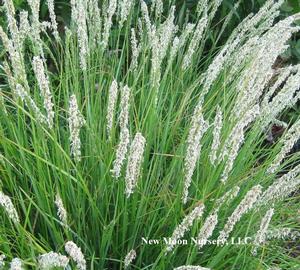Printed at http://www.newmoonnursery.com/index.cfm/
Sesleria autumnalis
Autumn Moor Grass
Native to Southeastern Europe
FIRST IMPRESSIONS: Sesleria autumnalis is a low mounding cool season perennial grass. Foliage is evergreen and arching. Blades have a striking yellow-green color that sometimes develops a soothing golden autumn tint. Spike-like silvery flowers rise above the leaves and mature into soft tan seed heads by autumn. This adaptive grass prospers in sunny sites with a wide variety of soils.
HABITAT & HARDINESS: Sesleria autumnalis is native to grasslands, meadows and open woods of southern Europe and the Caucasus region. Plants occur from eastern and northern Italy to Albania.
This species flourishes throughout the United States except for the hot desert and hot humid Southeastern states.
Plants are hardy from USDA Zones 5-9.
PLANT DESCRIPTION: Sesleria autumnalis forms upright tufted mounds of arching evergreen foliage.
Blades are narrow, v-shaped and about 1/4” wide and 8-12” long. Foliage is a bright yellow-green or chartreuse. Leaves may develop bronze autumn tints in some situations.
Silvery spiky inflorescences usually appear in autumn. In warm climates, however, flowering may begin in spring or summer.
The inflorescences are 4-6” long and about ¼” wide. They are purplish with silky white stamens. Elongated golden brown seed heads follow and usually persist through the winter.
Blooming plants are about 24” tall and 18’ wide.
CULTURAL & MAINTENANCE NEEDS: Sesleria autumnalis prospers in sunny or lightly shaded sites with average or dry well drained soil and consistent moisture.
Plants tolerate a wide range of conditions - dry shade, excess salinity, drought, alkaline pH and many different soil types. This species tolerates harsh urban environments and the difficult conditions associated with Black Walnut trees.
This is a cool season grass that does much of its growing during chilly weather. Mulch should be applied to protect roots from cold and help conserve water in summer.
Plants should be groomed or cut to the ground in late winter to remove tattered foliage and make way for new foliage.
This grass is pest resistant and fairly unpalatable to deer and other herbivores. It is, however, intolerant of high summer heat and humidity.
It is reported that this grass rarely reseeds in the garden.
LANDSCAPE USES: Sesleria autumnalis is a handsome Groundcover that brightens sunny Meadows. The species is sometimes used as an Accent, Edging or Mass Planting. Plants provide Winter Interest and Erosion Control to Deer Resistant Plantings, Low Maintenance Gardens, Perennial Borders or Rock Gardens.
COMPANION & UNDERSTUDY PLANTS: Try pairing Sesleria autumnalis with Amsonia ‘Blue Ice’, Chasmanthium latifolium, Deschampsia caespitosa, Echinacea purpurea, Liatris spicata ‘Kobold’, Penstemon calycosus or Sporobolus heterolepis.
Sesleria caerulea has similar habit and cultural needs and can be substituted if needed.
TRIVIA: The generic name is in honor of Leonardo Selser, 18th century Italian botanist. The specific epithet is due to the fall flowers.
This species is a favorite of renowned garden designer Piet Oudolf. It is planted in masses in New York City’s Highline and Chicago’s Lurie Garden.
Listed as one of the “100 Must-Have Garden Plants” in Gardens Illustrated Magazine.
Height:
9-24 inSpread:
12-18 inSpacing:
18-24 inUSDA Hardiness Zone:
5-9Bloom Color:
WhiteSesleria autumnalis Characteristics
Attracts Wildlife
- Pollinators
Attributes
- Rock Garden
- Ground Cover
- Interesting Foliage
- Drought Tolerant
- Dried Flower
Exposure
- Full Sun to Partial Shade
Deer Resistant
- Deer Resistant
Flowering Months
- April
Foliage Color
- Chartreuse
Grass Season
- Cool Season Grass
Groundcover Foot-Traffic Tolerances
- Moderate
Growth Rate
- Medium
Juglans nigra Tolerance (Black Walnut)
- Yes
Lawn Replacement or Groundcover
- Groundcover
Season of Interest (Foliage)
- Winter
- Fall
- Summer
- Spring
Soil Moisture Preference
- Moist to Dry
Interesting Notes:
This species is a favorite of renowned garden designer Piet Oudolf. It is planted in masses in New York City’s Highline and Chicago’s Lurie Garden.
Listed as one of the “100 Must-Have Garden Plants” in Gardens Illustrated Magazine.

